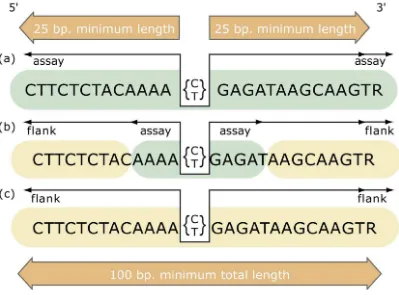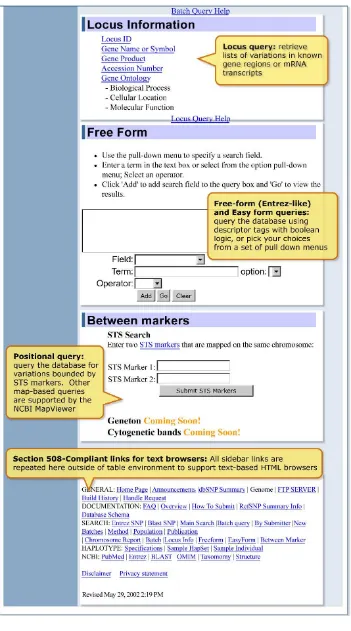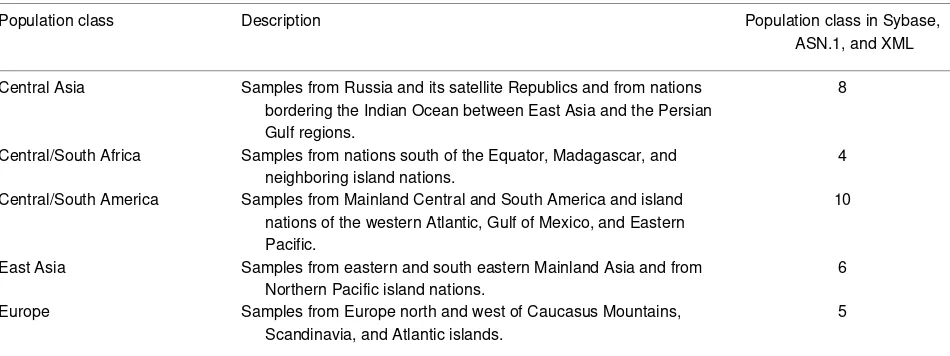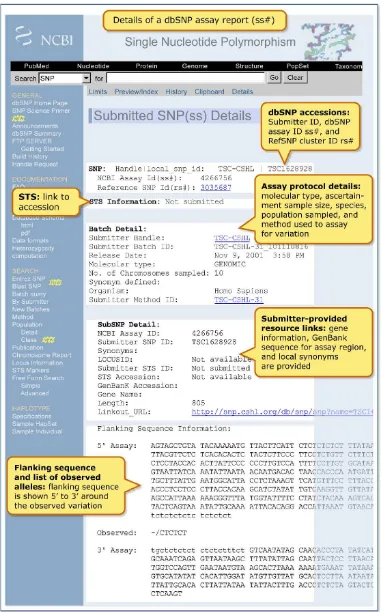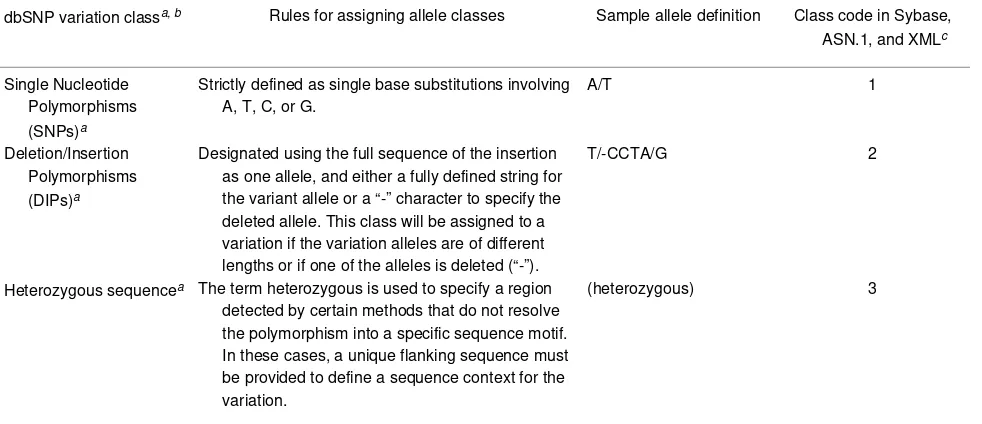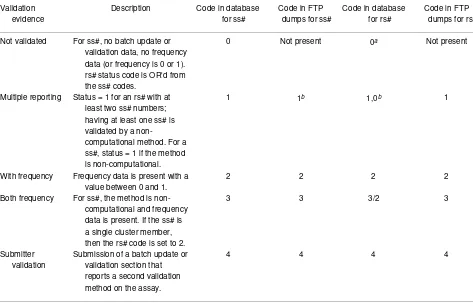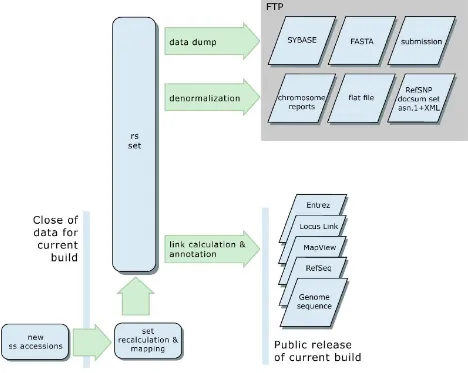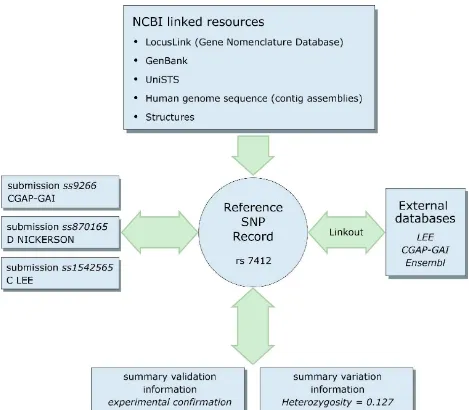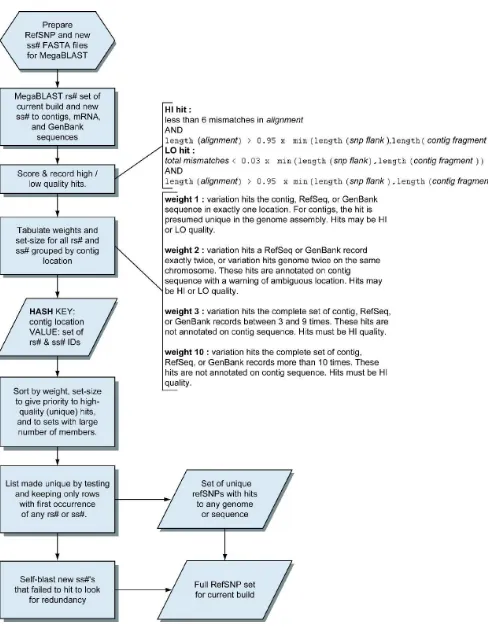5. The Single Nucleotide Polymorphism Database
(dbSNP) of Nucleotide Sequence Variation
Adrienne Kitts and Stephen Sherry
Created: October 9, 2002 Updated: August 13, 2003
Summary
Sequence variations exist at defined positions within genomes and are responsible for individual phenotypic characteristics, including a person's propensity toward complex disorders such as heart disease and cancer. As tools for understanding human variation and molecular genetics, sequence
variations can be used for gene mapping, definition of population structure, and performance of functional studies.
The Single Nucleotide Polymorphism database (dbSNP) is a public-domain archive for a broad collection of simple genetic polymorphisms. This collection of polymorphisms includes single-base nucleotide substitutions (also known as single nucleotide polymorphisms or SNPs), small-scale
multi-base deletions or insertions (also called deletion insertion polymorphisms or DIPs), and retroposable element insertions and microsatellite repeat variations (also called short tandem
repeats or STRs). Please note that in this chapter, you can substitute any class of variation for the term SNP. Each dbSNP entry includes the sequence context of the polymorphism (i.e., the
surrounding sequence), the occurrence frequency of the polymorphism (by population or individual),
and the experimental method(s), protocols, and conditions used to assay the variation.
The dbSNP accepts submissions for variations in any species and from any part of a genome.
This document will provide you with options for finding SNPs in dbSNP, discuss dbSNP content and organization, and furnish instructions to help you create your own (local) copy of dbSNP.
Introduction
Figure 1: The structure of the flanking sequence. The structure of the flanking sequence in dbSNP is a composite of bases either assayed for variation or included from published sequence. We make the distinction to distinguish regions of sequence that have been experimentally surveyed for variation (assay) from those regions that have not been surveyed (flank). The minimum sequence length for a variation definition (SNPassay) is 25 bp for both the 5′ and 3′ flanks and 100 bp overall to ensure an adequate sequence for accurate mapping of the variation on reference genome sequence. (a) Flanking sequence completely surveyed for variation. Both 5′ and 3′ flanking sequence can be defined with 5′_assay and 3′_assay fields, respectively, when all flanking sequence was examined for variation. This can occur in both experimental contexts (e.g., denaturing high-pressure liquid chromatography or DNA sequencing) and computational contexts (e.g., analysis of BAC overlap sequence). (b) Partial survey of flanking sequence can occur when detection methods examine only a region of sequence surrounding the variation that is shorter than either the 25 bp per flank rule or the 100 bp overall length rule. In these experimental designs (e.g., chip hybridization, enzymatic cleavage), we designate the experimental sequence 5′_assay or 3′ _assay, and you can insert published sequence (usually from a gene reference sequence) as 5′_flank or 3′_flank to construct a sequence definition that will satisfy the length rules. (c) Unknown or no survey of flanking sequence can occur when variations are captured from published literature without an indication of survey conditions. In these cases, the entire flanking sequence is defined as 5′_flank and 3′ _flank.
Physical Mapping
F unctional Analysis
Variations that occur in functional regions of genes or in conserved non-coding regions can cause significant changes in the complement of transcribed sequences, leading to changes in protein expression that can affect aspects of the phenotype such as metabolism or cell signaling. We note possible functional implications of DNA sequence variations in dbSNP in terms of how the variation alters mRNA transcripts.
Association Studies
The associations between variations and complex genetic traits are more ambiguous than simple, single-gene mutations that lead to a phenotypic change. When multiple genes are involved in a trait, then the identification of the genetic causes of the trait requires the identification of the chromosomal segment combinations, or haplotypes, that carry the putative gene variants.
E volutionary Studies
The variations in dbSNP currently represent an uneven but large sampling of genome diversity. The human data in dbSNP include submissions from the SNP Consortium, variations mined from genome sequence as part of the human genome project, and individual lab contributions of varia-tions in specific genes, mRNAs, ESTs, or genomic regions.
Null Results Are Important
Systematic surveys of sequence variation will undoubtedly reveal sequences that are invariant in the sample. These observations can be submitted to dbSNP as NoVariation records that record the sequence, the population, and the sample size that were used in the survey.
Searching dbSNP
Figure 2: The dbSNP homepage. We organized the dbSNP homepage with links to documentation, FTP, and sub-query pages on the
E ntrez SNP
The dbSNP is now a part of the Entrez integrated information retrieval system (Chapter 15) and may be searched using either qualifiers (aliases) or a combination of 28 different search fields. A complete list of the qualifiers and search fields can be found on the Entrez SNP site.
Single Record (Search by IDs) Query in dbSNP
Use this query module to select SNPs based on dbSNP record identifiers. These include refer-ence SNP (refSNP) cluster ID numbers (rs#), submitted SNP Accession numbers (ss#), and local (or submitter) IDs for the same variations.
SNP Submission Information Queries
Use this module to construct a query that will select SNPs based on submission records by labo-ratory (submitter), new data (called “new batches”, this query limitation is more recent than a user-specified date), methods used to assay for variation (Table 1), populations of interest (Table 2), or publication information.
Table 1. Method classes organize submissions by a general methodological or experimental approach to assaying for variation in the DNA sequence.
Method class Class code in Sybase, ASN.1, and XML
Denaturing high pressure liquid chromatography (DHPLC) 1
DNA hybridization 2
Computational analysis 3
Single-stranded conformational polymorphism (SSCP) 5
Other 6
Unknown 7
Restriction fragment length polymorphism (RFLP) 8
Direct DNA sequencing 9
Table 2. Population classes organize population samples by geographic region.
Population class Description Population class in Sybase, ASN.1, and XML
Central Asia Samples from Russia and its satellite Republics and from nations bordering the Indian Ocean between East Asia and the Persian Gulf regions.
8
Central/South Africa Samples from nations south of the Equator, Madagascar, and neighboring island nations.
4
Central/South America Samples from Mainland Central and South America and island nations of the western Atlantic, Gulf of Mexico, and Eastern Pacific.
10
East Asia Samples from eastern and south eastern Mainland Asia and from Northern Pacific island nations.
6
Europe Samples from Europe north and west of Caucasus Mountains, Scandinavia, and Atlantic islands.
Population class Description Population class in Sybase, ASN.1, and XML
Multi-National Samples that were designated to maximize measures of heterogeneity or sample human diversity in a global fashion. Examples include OEFNER|GLOBAL and the CEPH repository.
1
North America All samples north of the Tropic of Cancer, including defined samples of United States Caucasians, African Americans, Hispanic Americans, and the NHGRI polymorphism discovery resource (NCBI|NIHPDR).
9
North/East Africa and Middle East
Samples collected from North Africa (including the Sahara desert), East Africa (south to the Equator), Levant, and the Persian Gulf.
2
Pacific Samples from Australia, New Zealand, Central and Southern Pacific Islands, and Southeast Asian peninsular/island nations.
7
Unknown Samples with unknown geographic provinces that are not global in nature.
11
West Africa Sub-Saharan nations bordering the Atlantic north of the Congo River and central/southern Atlantic island nations.
3
dbSNP Batch Query
Use sets of variation IDs collected from other queries to generate a variety of SNP reports.
Locus Information Query
The links in this section all point to the NCBILocusLink resource. This resource permits users to query for records by gene name, gene symbol, gene product, gene ontology, or Accession num-ber. Records in LocusLink will have a pointer back to dbSNP if you have associated one or more variations with a gene feature.
F ree F orm (E ntrez-like) and E asy F orm Queries
Free Form is the most flexible query structure in dbSNP. Modeled on the NCBI Entrez retrieval system, queries can be conducted using multiple database field values to restrict a query to spe-cific subsets of data. The Easy Form query is identical to the Free Form query, with the exception that the Easy Form query has a series of pull-down menus from which a value can be selected for the most popular query fields.
Between-Markers Positional Query
ADA Section 508-compliant Link
All links located on the left sidebar of the dbSNP homepage are also provided in text format at the bottom of the page to support browsing by text-based Web browsers. Suggestions for improving database access by disabled persons should be sent to: [email protected].
Submitted Content
A complete copy of the SNP database is publicly available and can be downloaded from the SNP FTP [ftp.ncbi.nih.gov/snp/] site (see the section How to Create a Local Copy of dbSNP). dbSNP accepts submissions from public laboratories and private organizations. (There are online instructions [http://www.ncbi.nlm.nih.gov/SNP/get_html.cgi?whichHtml=how_to_submit] for preparing a submission to dbSNP.) A short tag or abbreviation called Submitter HANDLE
uniquely defines each submitting laboratory and groups the submissions within the database. The 10 major data elements of a submission follow.
F lanking Sequence Context DNA or cDNA
The essential component of a submission to dbSNP is the nucleotide sequence itself. dbSNP accepts submissions as either genomic DNA or cDNA (i.e., sequenced mRNA transcript) sequence. Sequence submissions have a minimum length requirement to maximize the speci-ficity of the sequence in larger contexts, such as a reference genome sequence. We also struc-ture submissions so that the user can distinguish regions of sequence actually surveyed for variation from regions of sequence that are cut and pasted from a published reference sequence to satisfy the minimum-length requirements. Figure 1 shows the details of flanking sequence structure.
Alleles
Alleles define variation class (Table 3). In the dbSNP submission scheme, we define single-nucleotide variants as G, A, T, or C. We do not permit ambiguous IUPAC codes, such as N, in the allele definition of a variation. In cases where variants occur in close proximity to one another, we permit IUPAC codes such as N, and in the flanking sequence of a variation, we actually encour-age them. See Table 3 for the rules that guide dbSNP post-submission processing in assigning allele classes to each variation.
Table 3. Allele definitions define the class of the variation in dbSNP.
dbSNP variation classa, b Rules for assigning allele classes Sample allele definition Class code in Sybase,
ASN.1, and XMLc
Single Nucleotide Polymorphisms (SNPs)a
Strictly defined as single base substitutions involving A, T, C, or G.
A/T 1
Deletion/Insertion Polymorphisms (DIPs)a
Designated using the full sequence of the insertion as one allele, and either a fully defined string for the variant allele or a “-” character to specify the deleted allele. This class will be assigned to a variation if the variation alleles are of different lengths or if one of the alleles is deleted (“-”).
T/-CCTA/G 2
Heterozygous sequencea The term heterozygous is used to specify a region
detected by certain methods that do not resolve the polymorphism into a specific sequence motif. In these cases, a unique flanking sequence must be provided to define a sequence context for the variation.
dbSNP variation classa, b Rules for assigning allele classes Sample allele definition Class code in Sybase,
ASN.1, and XMLc
Microsatellite or short tandem repeat (STR)a
Alleles are designated by providing the repeat motif and the copy number for each allele. Expansion of the allele repeat motif designated in dbSNP into full-length sequence will be only an approximation of the true genomic sequence because many microsatellite markers are not fully sequenced and are resolved as size variants only.
(CAC)8/9/10/11 4
Named varianta Applies to insertion/deletion polymorphisms of longer
sequence features, such as retroposon dimorphism for Alu or line elements. These variations frequently include a deletion “-” indicator for the absent allele.
(alu) / - 5
No-variationa Reports may be submitted for segments of sequence
that are assayed and determined to be invariant in the sample.
(NoVariation) 6
Mixedb Mix of other classes 7
Multi-Nucleotide
Polymorphism (MNP)a
Assigned to variations that are multi-base variations of a single, common length.
GGA/AGT 8
a Seven of the classes apply to both submissions of variations (submitted SNP assay, or ss#) and the non-redundant refSNP clusters
(rs#'s) created in dbSNP.
b The “Mixed” class is assigned to refSNP clusters that group submissions from different variation classes.
c Class codes have a numeric representation in the database itself and in the export versions of the data (ASN.1 and XML).
Method
Each submitter defines the methods in their submission as either the techniques used to assay variation or the techniques used to estimate allele frequencies. We group methods by method class (Table 1) to facilitate queries using general experimental technique as a query field. The submitter provides all other details of the techniques in a free-text description of the method. Submitters can also use the METHOD_EXCEPTION field to describe changes to a general pro-tocol for particular sets of data (batch-specific details). Submitters generally define methods only once in the database.
Population
Sample Size
There are two sample-size fields in dbSNP. One field is called the SNPASSAY SAMPLE SIZE, and it reports the number of chromosomes in the sample used to initially ascertain or discover the variation. The other sample size field is called SNPPOPUSE SAMPLE SIZE, and it reports the number of chromosomes used as the denominator in computing estimates of allele frequencies. These two measures need not be the same.
Population-specific Allele F requencies
Alleles typically exist at different frequencies in different populations; a very common allele in one population may be quite rare in another population. Also, allelic variants can emerge as private polymorphisms when particular populations have been reproductively isolated from neighboring groups, as is the case with religious isolates or island populations. Frequency data are submitted to dbSNP as allele counts or binned frequency intervals, depending on the precision of the exper-imental method used to make the measurement. dbSNP contains records of allele frequencies for specific population samples defined by each submitter (Table 4).
Table 4. Validation status codes summarize the available validation data in assay reports and refSNP clusters.
Not validated For ss#, no batch update or validation data, no frequency data (or frequency is 0 or 1). rs# status code is OR'd from the ss# codes.
0 Not present 0a Not present
Multiple reporting Status = 1 for an rs# with at least two ss# numbers; having at least one ss# is validated by a
non-computational method. For a ss#, status = 1 if the method is non-computational.
1 1b 1,0b 1
With frequency Frequency data is present with a value between 0 and 1.
2 2 2 2
Both frequency For ss#, the method is non-computational and frequency data is present. If the ss# is a single cluster member, then the rs# code is set to 2.
3 3 3/2 3
Submitter validation
Submission of a batch update or validation section that reports a second validation method on the assay.
4 4 4 4
a If the rs# has a single ss# with code 1, then rs# is set to code 0.
Population-specific Genotype F requencies
Similar to alleles, genotypes have frequencies in populations that can be submitted to dbSNP.
Population-specific Heterozygosity E stimates
Some methods for detection of variation (e.g., denaturing high-pressure liquid chromatography or DHPLC) can recognize when DNA fragments contain a variation without resolving the precise nature of the sequence change. These data define an empirical measure of heterozygosity when submitted to dbSNP.
Individual Genotypes
dbSNP accepts individual genotypes for samples from publicly available repositories such as CEPH or Coriell. Genotypes reported in dbSNP contain links to population and method descrip-tions as shown in Figure 3. General genotype data provide the foundation for individual haplotype definitions and are useful for selecting positive and negative control reagents in new experiments.
Validation Information
dbSNP accepts individual assay records (ss# numbers) without validation evidence. When possi-ble, however, we try to distinguish high-quality validated data from unconfirmed (usually computa-tional) variation reports. Assays validated directly by the submitter through the VALIDATION
section show the type of evidence used to confirm the variation. Additionally, dbSNP will flag an assay as validated (Table 4) when we observe frequency or genotype data for the record.
Computed Content (The dbSNP Build Cycle)
Figure 4: The dbSNP build cycle. The dbSNP build cycle starts with close of data for new submissions. We map all data, including existing refSNP clusters and new submissions, to reference genome sequence if available for the organism. Otherwise, we map them to non-redundant DNA sequences from GenBank. We then use map data on co-occurrence of hit locations to either merge submissions into existing clusters or to create new clusters. We then annotate the new non-redundant refSNP (rs) set on reference sequences and dump the contents of dbSNP in a variety of comprehensive and denormalized formats on the dbSNP FTP site for release with the online build of the database.
Mapping and Reclustering New Submissions
Each build starts with a “close of data” that defines the set of new submissions that will be mapped to genome sequence by MegaBLAST for subsequent reclustering and annotation. The set of new data entering each build typically includes all submissions received since the close of data in the previous build.
Resource Integration
build fresh indexes for dbSNP in Entrez and to update the variation map in the NCBI Map Viewer. Finally, we update links between dbSNP and dbMHC, UniSTS, LocusLink, PubMed, and Uni-Gene.
Public Release
Public release of a new build involves an update to the public database and the production of a new set of files on the dbSNP FTP site. We make an announcement to the dbsnp-announce [http://www.ncbi.nlm.nih.gov/mailman/listinfo/dbsnp-announce] mailing list when the new build is publicly available.
refSNP Cluster Assignment for Non-Redundant Datasets
Data submitted to dbSNP are clustered and provide a non-redundant set of variations for each organism in the database. We maintain these clusters as refSNPs in dbSNP in parallel to the underlying submitted data. We distinguish refSNPs from assay submissions by using an rs -prefixed (refSNP) Accession number instead of the ss-prefixed (submitted SNP) Accession number assigned to individual submissions.
Figure 5: Schematic view of refSNP rs7412 and its connections to underlying submissions ss9266, ss870165, and ss1542565.
rs7412 has an average heterozygosity of 12.7% based on the frequency data provided by the three submissions, and the cluster as a whole is validated because one of the underlying submissions has been experimentally validated. rs7412 is annotated as a variation fea-ture on RefSeq contigs, mRNAs, and proteins. Pointers in the refSNP summary record direct the user to additional information on the three submitter Web sites, through the linkout URLs supplied in each submission. These Web sites may contain additional data that were used in the initial variation call, or it may be additional phenotype or molecular data that indicate the function of the variation.
Summary Data Measures
We compute summary measures for each refSNP to integrate data provided by each indepen-dent submitter.
The refSNP Clustering Process
hits as either LO or HI quality and parse the hits to assign a weight to each refSNP. We make the set of all hits unique by dropping contig location and retaining only the first occurrence of each rs#, ss#, ID, and the cluster in which each ID number appears. The resulting data include all refSNPs for the current build that have at least one hit to contig, RefSeq, or GenBank sequence. We then compare the set of new submissions that fail to hit these sequence sets against each other using BLAST. This removes any potential redundancy in the incoming data, and unmapped refSNPs are instantiated for these data as well. This final merged set of data constitutes the refSNP set for the current build.
Once the clustering process determines the orientation of all member sequences in a cluster, it will gather a comprehensive set of alleles for a refSNP cluster.
Hint:
When the alleles of a submission appear to be different from the alleles of its parent refSNP, check the orientation of the submission for reverse orientation.
Summary Measures of Variation
The best single measure of a variation's diversity in different populations is its average heterozy-gosity. This measure serves as the general probability that both alleles are in a diploid individual or in a sample of two chromosomes. Estimates of average heterozygosity have an accompanying standard error based on the sample sizes of the underlying data, which reflects the overall uncer-tainty of the estimate.
Additional summary measures of variation include counts of populations and individuals sam-pled for this variation.
Mapping to Reference Genome Sequence
When reference genome assemblies are available, we use them as anchor sequence to place refSNP clusters into a genomic context. We clean dbSNP flanking sequence with RepeatMasker and then re-map them to the most current build of each genome using MegaBLAST. The map-ping results then define a new non-redundant set of variations for the genome.
Reclustering
We define a refSNP operationally as a variation at a location on an ideal reference chromosome. Such reference chromosomes are the goal of genome assemblies. However, work is still in progress in cases such as the human genome project; therefore, we must currently define a ref-SNP as a variation in the interim reference contig sequence. Every time there is a genomic assembly update, the interim reference contig sequence changes, and refSNPs must be updated or reclustered.
SNPs, or else the newly submitted SNPs cluster to an already existing refSNP. When newly submitted SNPs cluster among themselves, they are assigned to a new refSNP ID#, and when they cluster with an already existing refSNP, they are assigned to the cluster for that refSNP.
Sometimes a refSNP will co-locate with another existing refSNP. In this case, the refSNP with a higher ID number is retired, and all the submitted SNPs in its cluster are reassigned to the ref-SNP with the lower ID number.
Once the clusters are formed, the variation of a refSNP is the union of all possible alleles defined in the set of submitted SNPs that composed the cluster. Figure 6 is a detailed flow chart of the reclustering process.
NCBI Contig Annotation
We annotate weight 1 and 2 refSNP variations on NCBI RefSeq chromosomes, contig sequences, mRNAs, and proteins as variation features with multiple allele qualifiers (one per allele). Weight 2 records receive an additional warning note to indicate the ambiguous nature of the mapping result.
Hint:
The two hits that define a weight 2 variation may not reflect paralogy in the genome. Sequence assemblies are imperfect, and some regions of unique genome sequence are potentially reflected in two or more contig sequence fragments. Because we are currently unable to distinguish such cases from true paralogy, we annotate the variation in both locations with a warning and leave the assessment of the flanking sequence to the user.
We do not believe that weight 3 and weight 10 variations have sufficient utility to warrant their annotation, but the mapping results for these variations are still available in dbSNP.
We annotate NoVariation records on NCBI RefSeq chromosomes, contig sequences, mRNAs, and proteins as a miscellaneous feature, or misc_feat. All dbSNP annotations also include a db_Xref cross-reference pointer back to dbSNP that uses the refSNP ID number.
Annotating GenBank and Other RefSeq Records
GenBank records can be annotated only by their original authors. Therefore, when we find high-quality hits of refSNP records to the HTGS and non-redundant divisions of GenBank, we connect them using LinkOut (Chapter 17).
We annotate RefSeq mRNAs with variation features when the refSNP has a high-quality hit to the mRNA sequence. If the variation is in the coding region of the transcript and has a non-synonymous allele that changes the protein sequence, we also annotate the variation on the protein translation of the mRNA. The alleles in protein annotations are the amino acid translations of the affected codons.
NCBI Map Viewer Variation and Linkage Maps
shows the data as tick marks on the vertical coordinate scale. When variation is selected as the master map, a summary of map quality, quality warning, functional relationships to genes, aver-age heterozygosity with standard error, and validation information are provided. If genotype, haplotype, or LinkOut data are available, the master map will also contain links to this information.
Hint:
The summary values can be viewed or downloaded directly as a tab-delimited table if you select the Show Data as Table option from the left sidebar.
F unctional Analysis
Variation F unctional Class
We compute a functional context for sequence variations by inspecting the flanking sequence for gene features during the contig annotation process. We are also currently developing a method to do the same analysis on RefSeq/GenBank mRNAs.
Table 5 defines variation functional classes. We base class on the relationship between a variation and any local gene features. When a variation is near a transcript or in a transcript inter-val but not in the coding region, then we define the functional class by the position of the variation relative to the structure of the aligned transcript. In other words, a variation may be near a gene (locus region), in a UTR (mrna-utr), in an intron (intron), or in a splice site (splice site). If the varia-tion is in a coding region, then the funcvaria-tional class of the variavaria-tion depends on how each allele may affect the translated peptide sequence.
Table 5. Function codes for refSNPs in gene features. a
Functional class Description Database code
Locus region Variation is within 2 Kb 5′ or 500 bp 3′ of a gene feature (on either strand), but the variation is not in the transcript for the gene. This class is indicated with an L in graphical summaries.
1
Coding Variation is in the coding region of the gene. This class is assigned if the allele-specific class is unknown. This class is indicated with a C in graphical summaries.
2
Coding-synon The variation allele is synonymous with the contig codon in a gene. An allele receives this class when substitution and translation of the allele into the codon makes no change to the amino acid specified by the reference sequence. A variation is a
synonymous substitution if all alleles are classified as contig reference or coding-synon. This class is indicated with a C in graphical summaries.
3
Coding-nonsynon The variation allele is nonsynonymous for the contig codon in a gene. An allele receives this class when substitution and translation of the allele into the codon changes the amino acid specified by the reference sequence. A variation is a
nonsynonymous substitution if any alleles are classified as coding-nonsynon. This class is indicated with a C or N in graphical summaries.
4
mRNA-UTR The variation is in the transcript of a gene but not in the coding region of the transcript. This class is indicated by a T in
Functional class Description Database code
Intron The variation is in the intron of a gene but not in the first two or last two bases of the intron. This class is indicated by an L in graphical summaries.
6
Splice-site The variation is in the first two or last two bases of the intron. This class is indicated by a T in graphical summaries.
7
Contig-reference The variation allele is identical to the contig nucleotide. Typically, one allele of a variation is the same as the reference genome. The letter used to indicate the variation is a C or N, depending on the state of the alternative allele for the variation.
8
Coding-exception The variation is in the coding region of a gene, but the precise location cannot be resolved because of an error in the alignment of the exon. The class is indicated by a C in graphical summaries.
9
a Most gene features are defined by the location of the variation with respect to transcript exon boundaries. Variations in coding regions,
however, have a functional class assigned to each allele for the variation because these classes depend on allele sequence.
Typically, one allele of a variation will be the same as the contig (contig reference), and the other allele will be either a synonymous change or a nonsynonymous change. In some cases, one allele will be a synonymous change, and the other allele will be a nonsynonymous change. If any allele is a nonsynonymous change, then the variation is classified as a nonsynonymous vari-ation. Otherwise, the variation is classified as a synonymous varivari-ation.
•
The allele is the same as the contig (contig reference) and hence causes no change to the translated sequence.•
The allele, when substituted for the reference sequence, yields a new codon that encodes the same amino acid. This is termed a synonymous substitution.•
The allele, when substituted for the reference sequence, yields a new codon that encodes a different amino acid. This is termed a nonsynonymous substitution.•
A problem with the annotated coding region feature prohibits conceptual translation. In this case, we note the variation class as coding, based solely on position.Because functional classification is defined by positional and sequence parameters, two facts emerge: (a) if a gene has multiple transcripts because of alternative splicing, then a variation may have several different functional relationships to the gene; and (b) if multiple genes are densely packed in a contig region, then a variation at a single location in the genome may have multiple, potentially different, relationships to its local gene neighbors.
SNP Position in 3D Structure
known protein structures using BLAST. Then, if we find matches, we use the BLAST alignment to identify the amino acid in the protein of known structure that corresponds to the amino acid con-taining the SNP. We store the position of the amino acid on the 3D structure that corresponds to the amino acid containing the SNP in the dbSNP table SNP3D.
Resource Integration
Links from SNP Records to Submitter Websites
The SNP database supports and encourages connections between assay records (ss#'s) and supplementary data on the submitter's Web site. This connection is made using the LINKOUT
field in the SNPassay batch header. LinkOut URLs are base URLs to which dbSNP can append the submitter's ID for the variation to construct a complete URL to the specific data for the record. We provide LinkOut pointers in the batch header section of SNP detail reports and in the refSNP report cluster membership section.
Links within NCBI
We make the following connections between refSNP clusters and other NCBI resources during the contig annotation process:
LocusLink
There are two methods by which we localize variations to known genes: (a) if a variation is mapped to the genome, we note the variation/gene relationship (Table 5) during functional classi-fication and store the locus_id of the gene in the dbSNP table SNPContigLocusId; and (b) if the variation does not map to the genome, we look for high-quality blast hits for the variation against mRNA sequence. We note these hits with the protein_ID (PID) of the protein (the conceptual translation of the mRNA transcript). LocusLink scans this table nightly and updates the table MapLinkPID with the locus_id for the gene when the protein is a known product of a gene.
UniSTS
When an original submitted SNP record shows a relationship between a SNP and a STS, we share the data with dbSTS and establish a link between the SNP and the STS record. We also examine refSNPs for proximity to STS features during contig annotation. When we determine that a variation needs to be placed within an STS feature, we note the relationship in the dbSNP table SnpInSts.
UniGene
PubMed
We connect individual submissions to PubMed record(s) of publications cited at the time of sub-mission. If you want to view links from PubMed to dbSNP, select LinkOuts as a PubMed query result.
dbMHC
dbSNP stores the underlying variation data that define HLA alleles at the nucleotide level. The combinations of alleles that define specific HLA alleles are stored in dbMHC. dbSNP points to dbMHC at the haplotype level, and dbMHC points to dbSNP at both the haplotype and variation level.
How to Create a Local Copy of dbSNP
dbSNP is a relational database with about 100 tables. NCBI deploys dbSNP in both MSSQL and Sybase environments, and the public can download the full contents of the database from the dbSNP FTP site. The following sections will guide you in this process.
Schema: The dbSNP Physical Model
A schema is a necessary part of constructing your own copy of dbSNP because it is a visual rep-resentation of dbSNP and shows the logical relationship between data in dbSNP. It is available as a printable PDF file [ftp.ncbi.nih.gov/snp/Sybase/schema/PDM_dbSNP_work.pdf] from the dbSNP FTP site.
Data in dbSNP are organized into “zones” or boxes, depending on the nature of the data. Each zone is color coded to allow the viewer to find the data more easily. The current color group-ings are available [http://www.ncbi.nlm.nih.gov/About/outreach/gettgroup-ingstarted/snpftp/sybase.html] online. The data dictionary currently includes a description of all the tables in dbSNP, tables of columns and their properties, and tables of foreign keys in the conceptual model. Foreign keys are not enforced in the physical model because they make it harder to load table data asyn-chronously. In the future, we will add descriptions of individual columns. The data dictionary described above is available in rich text format in the file dbSNPdataDictionary.rtf.gz. The data are also available online from the dbSNP Web site.
Resources Required for Creating a Local Copy of dbSNP
Software:
•
Data loading tool. Loading data from the dbSNP FTP site into a database requires a bulk data-loading tool, which usually comes with a database installation. For example, we use the bcp (bulk-copy) utility that comes with Sybase.•
winzip/gzip to decompress FTP files. Complete instructions on how to uncompress *.gz and *.Z files can be found here [http://www.ncbi.nlm.nih.gov/Ftp/uncompress.html].•
Perl binaries (optional). There is a sample Perl script that validates whether all rows in the bcp file are loaded successfully into the table. See validating data loading in the Stepwise Procedure for Creating a Copy of dbSNP for more details.Hardware:
•
Computer platforms/OS. Databases can be maintained on any PC, Mac, or UNIX with an Internet connection.•
Disk space. Currently, a complete dbSNP database needs 20 GB. You need to first create a database of at least 20 GB in size. Aside from the database device size of 20 GB, you will also need another 15 GB to store downloaded data files before loading them into your database. Allowing space for other miscellaneous uses, we recommend free disk space of 40 GB.•
Internet connection. We recommend a high-speed connection to download such large database files.dbSNP Data Location
The FTP [ftp.ncbi.nlm.nih.gov/snp/Sybase/] directory contains the schema, data, and SQL state-ments to create the tables and indices for dbSNP. The /data subdirectory contains all data files of dbSNP tables, organized as one file per table. The file name convention is: <tablename>.bcp.gz. We use the Sybase bcp tool to generate the data files was one line per table row. Columns of data in each line are tab delimited.
The /schema subdirectory contains the files dbSNP_table.atx.gz and dbSNP_index.atx.gz. These files use standard SQL DDL language to create tables and indexes.
There are many utilities available to generate table/index creation statements from a database. We use a tool called atxtract to generate the files.
Stepwise Procedure for Creating a Local Copy of dbSNP
1. Prepare the local area. (check available space, etc.)
Hint:
For example, on UNIX operating systems, use gunzip to decompress the files: gunzip dbSNP_table.atx.gz gunzip dbSNP_index.atx.gz to get the files dbSNP_table.atx and dbSNP_index.atx.
3. Create the tables. Open dbSNP_table.atx file with a text editor. Replace 'snp_sherry' with the name of the database you have created on your server.
Hint:
If you are using Sybase and the SQL server, use the command isql -S <servername> -U username -P password -i dbSNP_table.atx
4. Download the data. Table data files can be found at: ftp://ftp.ncbi.nih.gov/snp/Sybase/ data [ftp.ncbi.nih.gov/snp/Sybase/data]. There are many pieces of FTP client software available that will facilitate downloading large number of files.
Hint:
Use “ftp -i” to turn off interactive prompting during multiple file transfers to avoid having to hit “yes” to confirm transfer hundreds of times.
5. Sample FTP protocol. Type ftp -i ftp.ncbi.nih.gov (use “anonymous” as the user name and your email as a password.) Type cd snp/Sybase/data. Type ls (if you see a list of <tablename>.bcp.gz files, you are in the right directory). Type binary (to set binary trans-fer mode). Type mget *.gz (to initiate transfer. Depending on the speed of connection, this may take more than 1 hour because the total transfer size currently is 1.5 GB and growing). To decompress the *.gz files, type gunzip *.gz (currently, the total size of the uncompressed bcp files is more than 10 GB).
6. Load data. Use the data-loading tool of your database server (e.g., bcp for Sybase).
Hint:
Because of the sheer volume of data, our tests to load data and then create indexes on a Sun Sparc Sybase server using “fast bcp” took about 8 hours.
7. Create indices. Open the dbSNP_index.atx file with a text editor and replace “snp_sherry” with the local name of the database as you have created it on your server. If you are using Sybase and the SQL server, use the command isql -S servername -U username -P password -i dbSNP_index.atx
8. Use scripts to automate data loading. In the dbSNP FTP snp/Sybase area, there is a sample UNIX C shell script cmd.loaddata that will combine tasks of creating tables, loading data, and creating indexes.
10. Data integrity (creating a partial local copy of dbSNP). dbSNP is a relational
database. Each table has either a unique index or a primary key. Foreign keys are not reinforced. There are advantages and a disadvantage to this approach. The advantages are: it makes it easy to drop and re-create the table using dbSNP_table.atx, which makes it possible to create a partial local copy of dbSNP. For example, if you are interested only in the original submitted SNP and their population frequencies and not in their map locations on NCBI genome contigs or GenBank Accession numbers (both are huge tables), then these tables can be skipped (i.e., SNPContigLoc and MapLink). Of course, to select tables for a particular query, the contents of each table and the dbSNP entity relationship (ER) diagram need to be understood. The disadvantage of unrein-forced references is that either the stored procedures or the external code needs to be written to ensure the referential integrity.
Appendix 1. dbSNP report formats.
ASN.1 Brief and F ull Versions
The file docsum.asn is the ASN structure definition file for both formats of the data. The 00readme file, located in the /specs subdirectory of the dbSNP FTP [ftp://ftp.ncbi.nih.gov/snp/] site, includes comments defining the sections common to both the full and the brief formats and the sections included in only the full version. ASN.1 text or binary output can be converted into one or more of the following formats: flatfile, FASTA, docsum, chromosome report, RS/SS, and XML. To do this, request ASN.1 output from either the dbSNP FTP site or the dbSNP batch query pages, and use dstool (located in the “bin” directory of the dSNP FTP site) to locally convert the output into as many alternative formats as needed.
XML Brief and F ull Versions
The XML DTD comprises three files located in the /specs subdirectory of the SNP FTP [ftp://ftp. ncbi.nih.gov/snp/] site: NSE.dtd, NSE.mod, and NCBI_Entity.mod (type definitions). The file NSE. dtd is simply a header file that bundles the two module files NCBI_Entity and NSE (NCBI SNP Exchange). The real structure definitions for the SNP data are in NSE.mod. This file is a direct conversion of the ASN.1 definition file (docsum.asn) into XML. All three XML files described above must be included in your download to parse the dbSNP XML data dumps successfully. The 00readme file located in the /specs subdirectory includes comments defining the sections com-mon to both the full and the brief formats and the sections included in only the full version.
F ASTA: ss and rs
BLAST SNP is useful for conducting a few sequence comparisons in the FASTA format, whereas multiple FASTA sequence comparisons will require the construction of a local BLAST database of FASTA formatted data and the installation of a local stand-alone version of BLAST.
rs docsum F latfile
The rs docsum flatfile report is generated from the ASN.1 datafiles and is provided in the files "/ ASN1_flat/ds_flat_chXX.flat". As with all of the large report dumps, files are generated per chro-mosome (chXX in file name). Because flatfile reports are compact, they will not provide you with as much information as the ASN.1 binary report, but they are useful for scanning human SNP data manually because they provide detailed information at a glance. A full description of the information provided in the rs docsum flatfile format is available in the 00readme file, located in the SNP directory of the SNP FTP [ftp://ftp.ncbi.nih.gov/snp/] site.
Chromosome Reports
The chromosome reports format provides an ordered list of RefSNPs in approximate chromo-some coordinates. Chromochromo-some reports is a small file to download but contains a great deal of information that might be helpful in identifying SNPs useful as markers on maps or contigs because the coordinate system used in this format is the same as that used for the NCBI genome Map Viewer. It should also be mentioned that the chromosome reports directory might contain the multi/ file and/or the noton/ files. These files are lists (in chromosome report format) of SNPs that hit multiple chromosomes in the genome and those that did not hit any chromosomes in the genome, respectively. A full description of the information provided in the chromosome reports format is available in the 00readme file, located in the SNP directory of the SNP FTP [ftp://ftp. ncbi.nih.gov/snp/] site.
Appendix 2. Rules and methodology for mapping.
A cycle of flank sequence masking and MegaBLAST alignment to the NCBI genome assembly of an organism is initiated either by the appearance of FASTA-formatted genome sequence for a new build of the assembly or by the significant accrual of newly submitted SNP data for that organism.
F lank Sequence Masking
We prepare FASTA-formatted sequence for unclustered ss assays of a particular organism and run RepeatMasker (with the mixed case option set) on the sequence, using the appropriate ALU-repeat library. For human, we use
repmask -q -xsmall
and for mouse we use
dust is used if no library of repetitive elements is available for the organism. The mixed case sequence is then loaded into the database, replacing the original submitted flank. The Sub-SNPRepMask table is updated with repeat masker output that describes the nature and location of the repeat, and a set of mixed-case FASTA is prepared for the entire refSNP set.
Organism-specific Genome Mapping
Both refSNP and subSNP FASTA sets are aligned to the genome assembly using MegaBLAST, and the SNP position is computed from the list of ungapped alignments returned with the -D1 option. We filter the alignments into either a high-threshold category (95 % of SNP flank aligning with fewer than sixth mismatches) or a low-threshold category (75% of the alignment length with fewer than 3% mismatches). The rest of the MegaBLAST alignments are dropped. MegaBLAST parameters are set to a default position with the exception of -F m, which suppresses seeding hits but allows extension through regions of lowercase sequence.
We also perform tailored BLAST algorithms to specialized subsets of the database that are known to fail or perform poorly in the standard pathway. Short sequences of 75 bases or fewer are BLASTed with word size = 22. To capture hits in cases where the variation length might break the alignment, each flank of microsatellites or indels are BLASTed independently and paired up in post processing to provide the SNP position. We perform high-stringency BLASTs for many of the heavily masked SNPs using wordsize = 40 and 99% quality in any alignment. This is an attempt to capture low-multiplicity hits of repetitive sequence without overburdening the BLAST algorithm with a large number of seeded alignments.
To reduce hit multiplicity in cases where SNPs align several times on the genome, we exam-ine the relative hit quality of multiple hits. Hits are discarded when the mismatch count is greater than the minimum mismatch count. The mismatch count parameter is currently set to 3. We BLAST refSNPs and subSNPs against GenBank mRNA, RefSeq mRNA, and GenBank clone accessions by a similar procedure.
We send the output from the genome alignment (or clone alignment where a genome is not available) through a clustering procedure that assigns rs IDs to unclustered new submissions. In some cases, this clustering procedure will re-cluster existing refSNP clusters based on colocation on the genome. After clustering, we update BLAST output to synchronize the ss IDs and the re-clustered rs IDs to the associated refSNP cluster defined in the database. Location data are loaded into the database, whereas cumulative hit data for each mapped SNP are computed and loaded to the database. Finally, we update SNPFlankStatus.
Appendix 3. 3D structure neighbor analysis.
First, contig annotation results provide the SNP ID (snp_id), protein accession (protein_acc), contig and SNP amino acid residue (residue), as well as the amino acid position (aa_position) for a particular RefSNP. These data can be found in the dbSNP table, SNPContigLocusId. FASTA sequence is then obtained for each protein accession using the program idfetch, with the com-mand line parameters set to:
-t 5 -dp -c 1 -q
We BLAST these sequences against the PDB database using blastall with the command line parameters set to:
-p blastp -d pdb -i protein.fasta -o result.blast -e 0.0001 -m 3 -I T -v 1 -b 1
